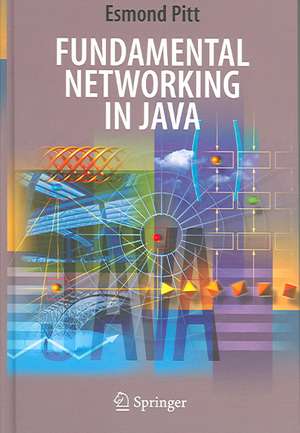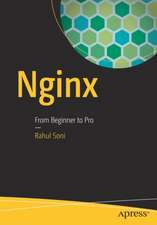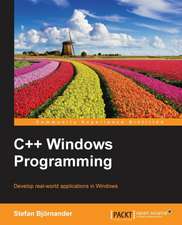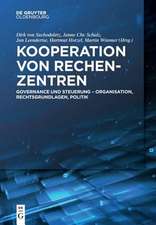Fundamental Networking in Java
Autor Esmond Pitten Limba Engleză Hardback – 10 oct 2005
After reading this book the reader will have an advanced knowledge of fundamental network design and programming concepts in the Java language, enabling them to design and implement distributed applications with advanced features and to predict their performance. Special emphasis is given to the scalable I/O facilities of Java 1.4 as well as complete treatments of multi-homing and UDP both unicast and multicast.
| Toate formatele și edițiile | Preț | Express |
|---|---|---|
| Paperback (1) | 337.52 lei 43-57 zile | |
| SPRINGER LONDON – 13 oct 2010 | 337.52 lei 43-57 zile | |
| Hardback (1) | 341.95 lei 43-57 zile | |
| SPRINGER LONDON – 10 oct 2005 | 341.95 lei 43-57 zile |
Preț: 341.95 lei
Preț vechi: 427.44 lei
-20% Nou
Puncte Express: 513
Preț estimativ în valută:
65.45€ • 71.12$ • 55.02£
65.45€ • 71.12$ • 55.02£
Carte tipărită la comandă
Livrare economică 21 aprilie-05 mai
Preluare comenzi: 021 569.72.76
Specificații
ISBN-13: 9781846280306
ISBN-10: 1846280303
Pagini: 399
Ilustrații: XVIII, 382 p. 23 illus.
Dimensiuni: 155 x 235 x 24 mm
Greutate: 0.68 kg
Ediția:2006
Editura: SPRINGER LONDON
Colecția Springer
Locul publicării:London, United Kingdom
ISBN-10: 1846280303
Pagini: 399
Ilustrații: XVIII, 382 p. 23 illus.
Dimensiuni: 155 x 235 x 24 mm
Greutate: 0.68 kg
Ediția:2006
Editura: SPRINGER LONDON
Colecția Springer
Locul publicării:London, United Kingdom
Public țintă
Professional/practitionerCuprins
to Networking.- IP—Internet Protocol.- Fundamentals of IP.- TCP—Transmission Control Protocol.- Fundamentals of TCP.- Scalable I/O.- Scalable TCP.- Firewalls.- Secure Sockets.- Scalable Secure Sockets.- UDP—User Datagram Protocol.- Unicast UDP.- Scalable UDP.- Multicast UDP.- In Practice.- Server and Clients Models.- Fallacies of Net- working.
Textul de pe ultima copertă
This book is an in-depth learning and teaching resource for the understanding and programming of TCP/IP networking in Java. It covers 'everything you can do to a socket in Java' and explains when and why you might - or might not - want to do that. It is addressed both to professional programmers and college students in first or second year networking courses.
The book covers TCP and UDP using both blocking streams and non-blocking channels, and also SSL secure sockets in both blocking and non-blocking modes, unravelling the mysteries of the SSLEngine in the process. Particular attention is paid to the neglected topics of multi-homing and multicast. A unique chapter on client and server architectures uses a quantitative approach rather than the usual design-patterns approach, leading to architectures with predictable performance rather than just coding elegance.
All you need to know about:
- Using Streams and Sockets for blocking TCP/IP
- Using Buffers and Channels for non-blocking and multiplexed TCP/IP and UDP
- Designing servers for scalability and predictable performance
- Working with blocking TLS/SSL using Streams and SSLSockets
- Unlocking the mysteries of non-blocking TLS/SSL with the JDK 1.5 SSLEngine
- Using DatagramSockets and DatagramPackets for blocking UDP and multicasting
- Outlining special programming considerations for multihomed hosts
- Managing the transition from IPv4 to IPv6 in Java
Features:
- Extensive Java index
- Accompanying [SVL] website XXXXX with source code download
- Comprehensive code samples and some exercises.
Esmond Pitt is a Melbourne consultant and author with a distinguished 28-year international career in the design and implementation of systems software products. A well-known Java advisor, he has published a book on Java RMI, and is a member of Sun's Expert Group on Distributed Real-time Java. His IT practice encompasses compiler construction, networking, and security. He is a Fellow of the Australian Computer Society.
I was an early reviewer of this book and I admire its economical and thorough but eminently readable style, lucidly describing complex issues without ever outstaying its welcome. This book combines academic rigour with a practical approach deeply informed by real-world experience and I have no hesitation in recommending it to developers of all experience levels. Experienced engineers building network-centric infrastructure or services should not be without this book. In fact, any Java developer building distributed applications such as J2EE, Jini, and Web Services should read this book — at least to understand the fundamental implications of networking on application design and implementation.
Michael Geisler, Sun Microsystems
The book covers TCP and UDP using both blocking streams and non-blocking channels, and also SSL secure sockets in both blocking and non-blocking modes, unravelling the mysteries of the SSLEngine in the process. Particular attention is paid to the neglected topics of multi-homing and multicast. A unique chapter on client and server architectures uses a quantitative approach rather than the usual design-patterns approach, leading to architectures with predictable performance rather than just coding elegance.
All you need to know about:
- Using Streams and Sockets for blocking TCP/IP
- Using Buffers and Channels for non-blocking and multiplexed TCP/IP and UDP
- Designing servers for scalability and predictable performance
- Working with blocking TLS/SSL using Streams and SSLSockets
- Unlocking the mysteries of non-blocking TLS/SSL with the JDK 1.5 SSLEngine
- Using DatagramSockets and DatagramPackets for blocking UDP and multicasting
- Outlining special programming considerations for multihomed hosts
- Managing the transition from IPv4 to IPv6 in Java
Features:
- Extensive Java index
- Accompanying [SVL] website XXXXX with source code download
- Comprehensive code samples and some exercises.
Esmond Pitt is a Melbourne consultant and author with a distinguished 28-year international career in the design and implementation of systems software products. A well-known Java advisor, he has published a book on Java RMI, and is a member of Sun's Expert Group on Distributed Real-time Java. His IT practice encompasses compiler construction, networking, and security. He is a Fellow of the Australian Computer Society.
I was an early reviewer of this book and I admire its economical and thorough but eminently readable style, lucidly describing complex issues without ever outstaying its welcome. This book combines academic rigour with a practical approach deeply informed by real-world experience and I have no hesitation in recommending it to developers of all experience levels. Experienced engineers building network-centric infrastructure or services should not be without this book. In fact, any Java developer building distributed applications such as J2EE, Jini, and Web Services should read this book — at least to understand the fundamental implications of networking on application design and implementation.
Michael Geisler, Sun Microsystems
Caracteristici
Addresses the new networking and I/O facilities of Java 1.4 and 1.5 First and only complete and correct textbook on fundamental networking in Java Addresses fundamental TCP/IP and UDP networking in Java in complete detail, from the level of individual packets of data all the way up to advanced design principles for network servers and clients, and including extensive coverage of multi-homing and UDP unicast Provides the first full-length book treatment of UDP multi-casting in Java: this is the Internet technology of the future, whose applications include the areas of sound and video, as well as software and data distribution Includes supplementary material: sn.pub/extras























